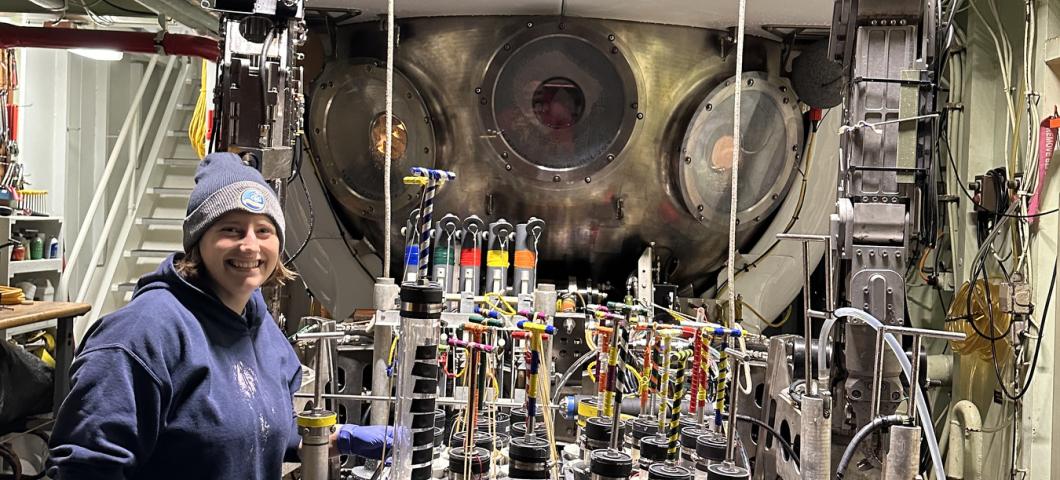Research and Discovery
A selection of highlights from this year's research endeavors across the College of Agriculture

Mark Anderson of the Department of Agricultural Economics and Economics published research in two prestigious journals examining the impact of marijuana laws on marijuana use by teenagers.
Economist Mark Anderson publishes research on teenage marijuana use in prestigious journal
By Reagan Cotton, MSU News Service
July 31, 2024
Nearly half of states in the U.S. have legalized marijuana for recreational use, while more than 35 states allow legalized medical use. And after evaluating an extensive body of research, a Montana State University economist has published comprehensive findings on the relationships between marijuana legalization and a slew of public health outcomes.
Mark Anderson, a professor in MSU’s Department of Agricultural Economics and Economics in the College of Agriculture, collaborated with researchers at San Diego State University to analyze data from a nationwide survey — the Youth Risk Behavior Survey, or YRBS — with trends in marijuana use both before and after legalization. The team’s findings were published in a research letter in the journal JAMA Psychiatry this spring in an article titled “Recreational Marijuana Laws and Teen Marijuana Use, 1993-2021.”
The research letter summarizes over 1.5 million responses to the YRBS about youth marijuana use in relation to the adoption of recreational marijuana laws. The authors analyzed YRBS responses from 1993 to 2021.
Read more about Anderson's economic research here.

Doctoral student Sylvia Nupp traveled to the Guaymas Basin to conduct deep sea research on the microbes that live in the extreme environments near the ocean floor.
Montana State team conducts deep-sea research more than 10,000 feet below ocean surface
By Reagan Cotton, MSU News Service
July 8, 2024
Postdoctoral researcher Andrew Montgomery and doctoral student Sylvia Nupp are part of associate professor Roland Hatzenpichler’s multidisciplinary lab in the Department of Chemistry and Biochemistry. This spring, Montgomery and Nupp traveled to the Guaymas Basin off the west coast of Mexico for a monthlong research cruise that made Nupp the first student from Montana to descend to the deep sea, according to Hatzenpichler.
It was a trip that Nupp had been preparing for since she arrived at MSU in 2021, after completing her undergraduate studies at the University of Arkansas.
“This happened to be the project that he had funding for at the time, so he asked if I would be interested in deep-sea research, and I said absolutely,” she recalled.
Hatzenpichler’s lab conducts a breadth of microbial research, from work exploring the human gut microbiome to examining the microbes that live in extreme environments, such as Yellowstone National Park’s thermal features. Nupp and Montgomery’s work on the ocean floor fell into the latter category, and the Guaymas Basin is an ideal location for such work.
Read more about Nupp and Montgomery's work in the Guaymas Basin here.

Extension specialist Hayes Goosey receives funding to study grasshoppers’ impact on pulse crops
By Reagan Cotton, MSU News Service
May 30, 2024
Hayes Goosey, assistant professor in the Department of Animal and Range Sciences in the College of Agriculture and an MSU Extension specialist, received roughly $330,000 through the USDA’s Specialty Crop Block Program, which supports research into the viability of crops such as fruits, vegetables, tree nuts and pulses. By examining the dietary preferences of grasshoppers, Goosey said, specialists will be able to make more precise and effective management prescriptions for growers.
Grasshopper populations follow drought, said Goosey, meaning that recent drought years in 2021 and 2022 have made the insects more of an issue in Montana, particularly east of the Continental Divide. Grasshoppers are highly attracted to spring and winter wheat, and there are three primary species that pose a threat in Montana: the migratory, clear-winged and two-striped grasshoppers. When droughts are particularly severe and rangeland acreage becomes dry, they will often migrate toward irrigated crop fields.
Goosey recommends scouting fields to estimate grasshopper prevalence. As grasshoppers mature, they progress through five instars, or stages, each of which requires the shedding and regrowing of an exoskeleton. Adults then lay eggs that can overwinter in the ground until the following spring.
Read more about Hayes Goosey's research and outreach work here.

Anna Nemudraia and Artem Nemudryi published research on RNA editing that has potential to change the way genetic illnesses are treated.
Montana State scientists’ research on RNA editing illuminates possible lifesaving treatments for genetic diseases
By Reagan Cotton, MSU News Service
April 26, 2024
Postdoctoral researchers Artem Nemudryi and Anna Nemudraia conducted research alongside Blake Wiedenheft, professor in the Department of Microbiology and Cell Biology in MSU’s College of Agriculture examining RNA editing. Their paper, titled “Repair of CRISPR-guided RNA breaks enables site-specific RNA excision in human cells,” was published in the journal Science and constitutes the latest advance in the team’s ongoing exploration of CRISPR applications for programmable genetic engineering.
CRISPR, which stands for Clustered Regularly Interspaced Short Palindromic Repeats, is a type of immune system that bacteria use to recognize and fight off viruses. Wiedenheft, one of the nation’s leading CRISPR researchers, said that the system has been used for years to cut and edit DNA, but that applying similar technology to RNA is unprecedented.
“In our previous work, we used type-III CRISPRs to edit viral RNA in a test tube,” said Nemudryi. “But we wondered, can we program manipulation of RNA in a living human cell?”
To explore that question, the team programmed type-III CRISPR proteins to cut RNA containing a mutation that causes cystic fibrosis, restoring cell function.
Read more about CRISPR research at MSU here.

Anna Schweiger received funding from NASA to conduct large-scale biodiversity research on a global scale.
NASA funding powers Montana State research into global biodiversity
By Reagan Cotton, MSU News Service
April 8, 2024
Anna Schweiger, who joined the faculty in the College of Agriculture’s Department of Land Resources and Environmental Sciences in August, received a grant of roughly $700,000 through NASA’s ROSES program, which stands for Research Opportunities in Space and Earth Sciences. With the funding, Schweiger will analyze data collected by a sensor on the International Space Station in preparation for the launch of a new satellite dedicated to collecting such data through a process called spectroscopy.
“Spectroscopy is an old science,” said Schweiger. “In the 1920s, botanists were working with plants to show that leaf reflectance changes as leaves age. An old leaf is chemically and structurally different than a younger leaf. Spectroscopy got a push during the age of space exploration, so spectrometers are now used to estimate the chemical composition of stars and of other planets, and at the same time, NASA is really interested in using that technology to also look at our own planet.”
Spectroscopy is a type of remote sensing that measures the amount of light reflected by various elements, including plants and bodies of water. It can be done at nearly any resolution imaginable, from a sensor focused on a single plant leaf to equipment on a satellite measuring ocean reflectance. Much of Schweiger’s career has been dedicated to bridging the gaps between those spatial resolutions to develop a clearer image of biodiversity across scales.
